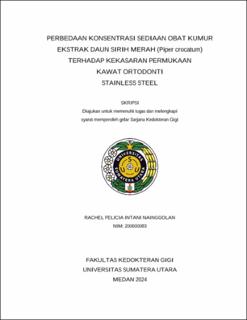| dc.description.abstract | Fixed orthodontic treatment is indicated in conditions where movement of several teeth is required for malocclusion correction and is in constant contact with the oral environment. Many factors affect the environment in the oral cavity, one of which is when rinsing the mouth. Surface roughness on orthodontic wires arising from corrosion from oral conditions can affect tooth movement resulting in longer treatment duration. Red betel leaf (Piper crocatum) can be utilized as a corrosion inhibitor because it has the benefit of reducing the surface roughness on the wire. The purpose of this study was to determine the changes surface roughness value of stainless steel orthodontic wire after immersion in artificial saliva solution, chlorhexidine 0.2%, red betel leaf extract mouthwash concentrations of 1% and 3% for 7, 14, and 21 days. The samples used were 36 stainless steel wires 0.016 inches in diameter with a length of 5 cm which were divided into 12 immersion groups. The mean surface roughness value was measured with a Profilometer. The results showed that the highest mean difference in surface roughness of stainless steel orthodontic wires occurred in the 0.2% chlorhexidine group for 7, 14, and 21 days, namely 0.068 ± 0.008 μm, 0.120 ± 0.015 μm, and 0.230 ± 0.021 μm. The lowest mean difference in surface roughness of stainless steel orthodontic wires occurred in the artificial saliva group for 7, 14, and 21 days, namely 0.032±0.008 μm, 0.054±0.017 μm, and 0.085±0.032 μm. The mean difference in surface roughness was lower in the 3% concentration of betel leaf mouthwash than the 1% concentration, which at 7, 14, and 21 days were 0.040±0.004 μm, 0.064±0.012 μm, and 0.117±0.006 μm. The test results showed a significant difference in the mean difference surface roughness of stainless steel orthodontic wires immersed in all groups where the significance value of p=0.002 on day 7, p=0.001 day 14, and p=0.000 day 21. | en_US |


